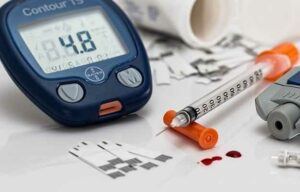Diabetic ketoacidosis (DKA) is a serious and potentially life-threatening complication often associated with type 1 diabetes, though it can also occur in type 2 diabetics in certain situations. This condition develops when your body is unable to produce enough insulin, leading to high blood sugar levels and a buildup of acids called ketones. In this blog, we’ll delve into the essential aspects of diabetic ketoacidosis medications, from the benefits and risks involved in it.
Contents
When Should I Consider Diabetic Ketoacidosis Medication?
 Recognizing when to consider medication for DKA involves understanding its warning signs and how they differ from your normal experiences with diabetes management. Key indicators include:
Recognizing when to consider medication for DKA involves understanding its warning signs and how they differ from your normal experiences with diabetes management. Key indicators include:
- High Blood Sugar Levels (Hyperglycemia): If your blood sugar levels are consistently high and unresponsive to your usual diabetes management routine, it could signal the onset of DKA.
- Presence of Ketones in Urine: Regular monitoring for ketones, especially when your blood sugar is high, is crucial. The presence of moderate to high levels of ketones is a warning sign.
- Severe Symptoms: Symptoms like extreme thirst, frequent urination, nausea, vomiting, abdominal pain, fatigue, shortness of breath, fruity-smelling breath, and confusion indicate a need for immediate medical attention.
- Illness or Infection: If you’re sick or have an infection, your body may produce more hormones that counteract insulin, potentially leading to DKA. Close monitoring during these times is essential.
- Missed Insulin Doses: Missing insulin doses can quickly lead to DKA, especially in type 1 diabetes. It’s vital to adhere to your insulin regimen.
If you experience any of these signs, especially in combination, it’s important to seek immediate medical attention. Early detection and intervention are crucial for preventing serious complications. Regular consultation with your healthcare provider and a comprehensive understanding of your diabetes management plan is imperative in reducing the risk of developing DKA.
What Are Some Diabetic Ketoacidosis Medication?
Diabetic ketoacidosis (DKA) is a serious and potentially life-threatening complication of diabetes that requires immediate medical attention. The primary goal in treating DKA is to correct the high blood glucose levels, dehydration, and electrolyte imbalances, and to suppress the production of ketone bodies. Below are some common diabetic ketoacidosis medication and treatment used in the management of DKA:
Insulin Therapy
The primary and most critical medication for treating DKA is insulin. In DKA, due to the lack of insulin, the body cannot use glucose and starts burning fat, leading to the production of ketones. Insulin therapy is administered to lower high blood glucose levels and to stop ketone production. This is typically done through intravenous (IV) insulin in a hospital setting for rapid effect. Insulin helps glucose enter the body’s cells. And, reducing blood glucose levels and halting the production of ketones. The dose and rate of insulin administration are carefully monitored and adjusted based on regular blood glucose testing.
Fluid Replacement
 Patients with DKA are often severely dehydrated due to high blood glucose levels leading to increased urination. As a result, fluid replacement is a crucial part of the treatment. IV fluids (usually saline) are administered to rehydrate the patient, correct electrolyte imbalances, and dilute the excess blood glucose. The type and amount of fluid depend on the patient’s hydration status, serum electrolyte levels, and kidney function. Adequate fluid replacement helps improve blood flow and kidney function, further aiding in the reduction of blood glucose levels and clearance of ketones.
Patients with DKA are often severely dehydrated due to high blood glucose levels leading to increased urination. As a result, fluid replacement is a crucial part of the treatment. IV fluids (usually saline) are administered to rehydrate the patient, correct electrolyte imbalances, and dilute the excess blood glucose. The type and amount of fluid depend on the patient’s hydration status, serum electrolyte levels, and kidney function. Adequate fluid replacement helps improve blood flow and kidney function, further aiding in the reduction of blood glucose levels and clearance of ketones.
Electrolyte Replacement
DKA often leads to significant electrolyte imbalances, particularly of potassium. The treatment includes careful monitoring and replacement of electrolytes. Potassium is of particular concern, as insulin treatment can drive potassium from the blood into cells, potentially leading to a dangerous condition known as hypokalemia (low blood potassium levels). Potassium supplements are often added to IV fluids to prevent or treat hypokalemia. Other electrolytes like sodium, chloride, and bicarbonate are also monitored and adjusted as needed to maintain the body’s acid-base balance.
Bicarbonate Therapy
In cases of severe acidosis (where the blood becomes too acidic), bicarbonate therapy may be used. However, its use is somewhat controversial and typically reserved for extreme cases where the pH level of the blood is dangerously low. Bicarbonate can help to correct the acid-base balance in the body. However, it must be used with caution, as it can lead to a rapid shift in the body’s pH and electrolyte balance, potentially causing complications.
It’s important to note that DKA is a medical emergency that requires treatment in a hospital setting. Self-treatment at home is not appropriate for DKA due to the need for intravenous therapy and close monitoring.
What Is The Drug Of Choice For Diabetic Ketoacidosis?
The primary drug of choice for treating diabetic ketoacidosis (DKA) is insulin. DKA is characterized by a significant deficiency of insulin in the body, leading to high blood sugar levels and the production of ketones. Insulin therapy is essential for reversing these effects. Here’s how insulin is used in the treatment of DKA:
- Intravenous Insulin
In a hospital setting, rapid-acting insulin is typically administered intravenously. This method allows for quick absorption and immediate action, which is crucial in a critical situation like DKA. Intravenous administration also allows healthcare providers to adjust insulin doses quickly based on blood sugar levels and the patient’s response.
- Restoring Normal Blood Sugar Levels
The immediate goal of insulin therapy in DKA is to lower high blood sugar levels to a safe range. Insulin helps to reduce blood glucose by facilitating its uptake into cells, thus addressing hyperglycemia.
- Halting Ketone Production
Insulin also helps to stop the breakdown of fat for energy. This is responsible for the production of ketones. By promoting the use of glucose for energy, insulin therapy reduces the production of ketones. Ultimately, helping to correct the metabolic acidosis associated with DKA.
- Transition to Subcutaneous Insulin
Once the patient’s blood sugar levels are stabilized and the acid-base balance is restored, the transition is made from intravenous insulin to the patient’s regular subcutaneous insulin regimen. This step is managed carefully to maintain blood sugar control and prevent the recurrence of DKA.
It’s important to note that insulin therapy in DKA is part of a broader treatment approach that includes fluid and electrolyte replacement to address dehydration and electrolyte imbalances, and treatment of any underlying causes, such as infections. The management of DKA is a complex process that requires close monitoring and individualized treatment plans.
What Are The Benefits And Risks Of Diabetic Ketoacidosis Medication?
 The treatment of Diabetic Ketoacidosis (DKA), primarily involving insulin therapy along with fluid and electrolyte management, has several benefits and risks that are crucial to understand.
The treatment of Diabetic Ketoacidosis (DKA), primarily involving insulin therapy along with fluid and electrolyte management, has several benefits and risks that are crucial to understand.
Benefits
- Restoration of Normal Blood Sugar Levels: Insulin therapy lowers dangerously high blood glucose levels. It is essential in reversing the immediate life-threatening condition of DKA.
- Reduction in Ketone Production: Insulin stops the excessive breakdown of fats for energy. Thereby reducing the production of ketone bodies, which are responsible for the acidosis in DKA.
- Correction of Acid-Base Balance: Along with insulin, the administration of fluids and electrolytes helps to correct the acid-base imbalance in the body, a critical aspect of managing DKA.
- Prevention of Complications: Prompt and effective treatment of DKA helps prevent serious complications such as cerebral edema, renal failure, and cardiac arrhythmias.
- Stabilization of Electrolyte Levels: The treatment includes careful management of electrolytes, particularly potassium. It is crucial for preventing cardiac and neuromuscular complications.
Risks
- Hypoglycemia (Low Blood Sugar): One of the risks associated with insulin therapy is hypoglycemia, which can occur if blood sugar levels drop too rapidly or too low. This is managed by careful monitoring and adjustment of insulin dosages.
- Hypokalemia (Low Potassium Levels): Insulin treatment can drive potassium into cells, leading to a potentially dangerous drop in blood potassium levels. This is closely monitored, and potassium is supplemented as necessary.
- Cerebral Edema: Although rare, this is a serious complication, particularly in children. It may occur due to rapid changes in osmotic gradients during treatment.
- Fluid Overload: Aggressive fluid replacement can lead to fluid overload. Especially in patients with compromised heart or kidney function. This requires careful balancing of fluid administration.
- Underlying Cause Complications: If the underlying cause of DKA (such as infection) is not adequately addressed, it may lead to further complications or delay the resolution of DKA.
- Allergic Reactions: Rarely, patients may have allergic reactions to insulin or other additives in insulin preparations.
Overall, while the treatment of DKA and other supportive measures is life-saving and essential, it requires careful monitoring and management to minimize the associated risks.
Conclusion
In conclusion, diabetic ketoacidosis medication is crucial for management. Effective treatment primarily involves insulin therapy, which helps lower dangerous blood sugar levels and reduce ketone production, coupled with fluid and electrolyte management to correct dehydration and imbalances. While these treatments are highly effective in managing and resolving DKA, they must be administered carefully to avoid potential risks.
The key to preventing DKA lies in diligent diabetes management, including regular blood sugar monitoring, adhering to insulin regimens, and being aware of the warning signs. Do you want to get rid of diabetes? Join our online diabetes treatment program and reverse Diabetes naturally through lifestyle changes such as a Personalized Diet plan, Exercise, Yoga, dieticians, and health coaches.

